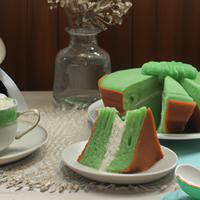
1 serving (100 grams) contains 300 calories, 5.0 grams of protein, 15.0 grams of fat, and 40.0 grams of carbohydrates.

Log this food in SnapCalorie

Nutrition Information
Calories |
721.2 | ||
|---|---|---|---|
% Daily Value* |
|||
| Total Fat | 36.1 g | 46% | |
| Saturated Fat | 12.0 g | 60% | |
| Polyunsaturated Fat | 0 g | ||
| Cholesterol | 120.2 mg | 40% | |
| Sodium | 480.8 mg | 20% | |
| Total Carbohydrates | 96.2 g | 34% | |
| Dietary Fiber | 2.4 g | 8% | |
| Sugars | 60.1 g | ||
| protein | 12.0 g | 24% | |
| Vitamin D | 0 mcg | 0% | |
| Calcium | 72.1 mg | 5% | |
| Iron | 2.4 mg | 13% | |
| Potassium | 240.4 mg | 5% | |
* Percent Daily Values are based on a 2,000 calorie diet. Your daily values may be higher or lower depending on your calorie needs.
Food Attributes
Source of Calories
About Pandan chiffon cake
Pandan Chiffon Cake is a light and airy dessert originating from Southeast Asia, particularly popular in Malaysian, Singaporean, and Indonesian cuisines. Its vibrant green color is derived from pandan leaves, which impart a unique, fragrant flavor often described as a blend of vanilla and coconut. The cake is traditionally made using a mix of eggs, sugar, flour, coconut milk, and vegetable oil, creating a moist and fluffy texture. While it contains no butter, making it lower in saturated fats compared to some other cakes, it does include refined sugar and flour, which limit its nutritional benefits. Pandan leaves themselves are rich in antioxidants, but their health benefits in this cake are minimal due to the small quantity used. Enjoyed on special occasions and as a tea-time treat, Pandan Chiffon Cake is celebrated more for its delicate taste and cultural significance than for its nutritional value.



